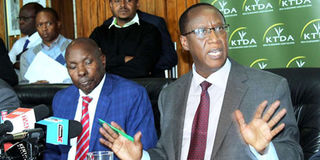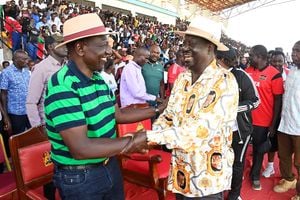KTDA entities that farmers own but which don’t earn them a single cent

KTDA CEO Lerionka Tiampati (right) and Vice Chairman Philip Ngetich during a press conference on October 3, 2019. PHOTO | FILE | NATION MEDIA GROUP
What you need to know:
- By the time of its privatisation in 2000, KTDA was holding over Sh1.4 billion belonging to 45 factory companies.
- While Parliament was told that this was realised from “savings on income” the reality was that this was money deducted by the KTDA barons from farmers
- The money was not held in shares but in cash. The DCI should start from here and find out where this money went.
The last time I wrote on the Kenya Tea Development Agency (KTDA), its lawyer threatened to sue me for “defaming” the organisation, which was once the bedrock of Kenya’s tea industry.
CONFLICT OF INTEREST
Last week, President Uhuru Kenyatta asked detectives to investigate the workings of this behemoth — which was turned from a government body to a private entity in a scandalous arrangement that left smallholder tea farmers at the mercy of a few directors stationed at the headquarters.
They are also to investigate the serious conflict of interest involving board members.
When detectives from the Directorate of Criminal Investigation start looking into the agency’s affairs, they will find out that it is a rogue body. They will find that conflict of interest reigns here as private companies in which directors have direct interests are awarded tenders to supply weighing machines and bags, to renovate factories and repair boilers and trade with the entity, which on paper, is owned by farmers.
But the worst part is that money from these subsidiary entities that were built using farmers’ money do not earn them any dividend, which explains why tea factory directors are never told how many shares their factory holds in KTDA and what income should go to their growers. At best, these directors don’t know the workings of KTDA or at worst, and for those who know, they are compromised.
NEVER REFLECTED
I have in many months spoken to factory directors who do not know whether these assets belong to KTDA or to the farmers — President Kenyatta would have done well to call for a commission of inquiry.
We know that KTDA, on behalf of smallholder growers, owns warehouses, commercial buildings in Nairobi and Mombasa, estates in Nairobi, beach houses in Mombasa, the sprawling 600-acre tea farm in Kangaita, an engineering company in Industrial Area, a microfinance institution known as Green Fedha, Majani Insurance and many others whose profits are never reflected in the shareholders’ annual pay.
When some of the projects were mooted, farmers were told that they would save a lot of money.
If these institutions were built using smallholders’ money, why do tea farmers never get a penny out of them? Who are these shadowy beneficiaries who have been gaining from these companies whose directorship is similar to that of KTDA Holdings? These are the questions President Kenyatta seemed to be asking when he ordered the DCI to dip its nose into KTDA matters.
ACCUMULATED SURPLUS
Recently, I was looking at KTDA archives to find out if indeed these assets it claims to own were built using farmers’ money. The first file I picked up — minutes of the board — had part of the evidence I wanted.
We can now authoritatively tell farmers that they directly contributed money for the setting up of these facilities from which they don’t get any dividend.
For instance, in 1980, their money was used to build three beach houses in Nyali, Mombasa, on LR 209/600/6 and 209/602/7 during the chairmanship of Charles Koinange. I have no idea how many more beach plots are owned by KTDA but if we dig into their archives, we might get the full story.
In those days they had something known as a green leaf price reserve, which was to be a price stabilisation mechanism but which was used to deposit money deducted from farmers’ pay every year.
The second payment, which farmers call a bonus, is actually accumulated surplus deposited in banks and held by KTDA in fixed accounts or in dollars, and this is the cash available to the board and management to play around with.
STORAGE CHARGES
Let me tell you the story of the Mombasa-based KTDA warehouse, because I now have first-hand evidence from archival papers.
Built on a 10-acre plot, the land on which it sits was acquired when Eliud Mahihu was the Provincial Commissioner, and built when he was the Tea Board of Kenya chairman. The acquisition of the land followed advice from then general manager Charles Karanja, who told the board that “containerisation of tea would in future become the more popular mode of transportation in the world”. This is captured in Min 52/80(6) of 1980. He then proposed that it would be important to build a warehouse in Mombasa, besides the containerisation depot in Nairobi’s Industrial Area, where KTDA had a plot.
The Authority, as it was then, was told by the Karanja management that the containerisation depot would create savings through the use of railway transport and reduce stuffing and storage charges, damage and contamination of tea as well as freight and insurance premiums.
DEDUCT MONEY
It was recorded that the Regional Controller of CDC Mr C.J. Stephenson asked the board to seek the services of a consultant to turn that idea into reality.
During a subsequent 3pm meeting held on February 22, 1985, and chaired by Mr Koinange, five members of a special committee of the KTDA board convened to decide where to get the money to build the container depot and a new KTDA headquarters. They unanimously resolved to deduct the money from tea farmers. No one asked the farmers and there are no records that the different companies under the umbrella of KTDA had been informed.
The particular resolution reads: “That the cost of the implementation of the development projects proposed on the authority’s said plot at the Industrial Area be financed through a retention of a sum equivalent to the cost of the proposed development from the Second Payment Surplus Funds accumulated at the end of this financial year.”
CASH COW
There was also abuse of power during the President Daniel Moi regime, and one case in point where farmers’ money was put into a project that they don’t own is the modern-day Nyayo Tea Zone.
Records at KTDA indicate that the management — even without the authority of the board — incurred expenditure to kick-start the Government Forest Tea Zone, as Nyayo Tea Zone was known then. Through a roadside directive, KTDA had been ordered, nay tasked, by President Moi to establish nurseries in which tea seedlings would be grown. The government did not put in any money to start that project, leaving it to the farmers.
KTDA had also been asked to build a factory and market the tea within the Nyayo Tea Zone belt. By then, the Nyayo Tea Zone parastatal had not been formed, and this shows how tea farmers have over the years become everyone’s cash cow.
On this one, and given the political notoriety of those days, the board decided to only express its hopelessness: “The management informed the Board that the government had failed to release (Sh15.8 million) the cost of establishing these first year nurseries.
FUND NURSERIES
Instead, the Board learnt, the permanent Secretary, Ministry of Agriculture and Livestock Development had asked the KTDA to fund the cost of establishing the nurseries … The management had argued against the proposal on grounds that the project was a Government project, and therefore should be fully funded by the Government …”
But finally, the board gave out all the 100,000 tea seedlings that had been grown at its Kangaita Tea Nursery and took another Sh100,000 to President Moi to finance the President’s Forest Fund. That is how farmer’s seedlings were used for the Nyayo Tea Zone.
When you look at some of the audited accounts of KTDA in the 1980s, you will see that money was generated from various sources, including Kagochi Training School and Kagochi Farm. These days, I am not sure many tea farmers know how much these entities fetch.
Something else found in the 1980s minutes was that farmers were subsidising local consumption of tea. Why the government and the Tea Board had allowed this to happen is not clear — and it is captured in an internal memo dated July 1984 for the Board.
TEA BARONS
While there were complaints that Kenya Tea Packers (Ketepa) was not earning KTDA any money, it was kept rolling and continued to be the main outfit through which farmers’ money was misappropriated.
The bad manners of yesteryears were inherited by the agency after the government decided to walk away from the task of safeguarding farmers’ interests in KTDA, thanks to a push by MPs from tea-growing areas. The problem with that hurried exit is that nobody knew what role the new agency was to play. So it changed its name and inherited the mischief of the authority.
By the time of its privatisation in 2000, KTDA was holding over Sh1.4 billion belonging to 45 factory companies. While Parliament was told that this was realised from “savings on income” the reality was that this was money deducted by the KTDA barons from farmers — since KTDA was not a profit-making organisation but a farmers’ service organisation. The money was not held in shares but in cash.
WHERE IS MONEY
Then minister Chris Obure told Parliament that the money was part of the “assets” inherited by the new agency and that its board of directors would meet and decide its distribution.
“I expect the distribution will be in form of shares to be allocated to the 45 tea factory companies,” said the minister.
The DCI should start from here and find out where this money went. There was an evaluation of KTDA assets carried out by Ernst & Young, and it would be important to check this out.
We should have listened to Prof Peter Anyang’ Nyong'o when he stated thus: “In privatising, it is important that the government realises that it must perfect itself as a regulatory agency. One of the crises in the tea industry is that the government does not know what to do with KTDA. Should it be a regulatory agency laying ground rules for the privatised tea sector, or should it continue to be an intervening agency in the economic running of these factories?”
NEAR COLLAPSE
Because we did not answer that question, we are now running to save an industry on the verge of collapse. But somehow, the farmers are still alive and the bushes are still there.
The question remains: Where does the money from KTDA subsidiaries vanish to?
[email protected] @johnkamau




